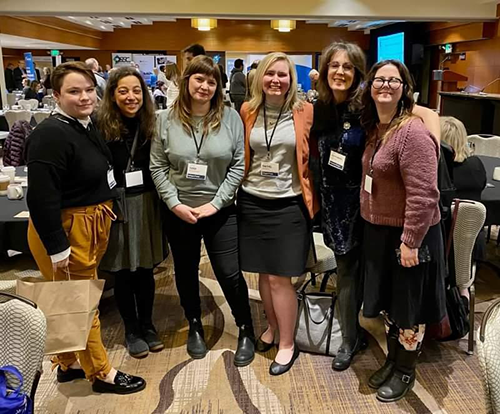Although I’ve been learning a lot about the different facets of publishing at Ooligan Press and in the Book Publishing Program, I wanted to learn more. So, when I heard the 2023 PubWest Conference was happening in Seattle, I jumped at the chance to attend.
The Publishers Association of the West (PubWest) is dedicated to offering professional education, providing publishing-related benefits, creating opportunities for members and associate members to do business, speaking as an advocate for members, recognizing outstanding achievement in publishing, and providing a forum for networking to their publishing and associate members from across the United States and Canada. Founded in 1977 as the Rocky Mountain Book Publishers Association, the association initially focused on supporting publishers in the West; it now consists of members across the US and Canada and even overseas.
This year’s PubWest Conference was unique in that it overlapped with The Book Manufacturers’ Institute’s (BMI) Book Manufacturing Mastered Conference. BMI supports book manufacturing leaders in their work to drive the promotion, efficiency, and growth of book markets for readers and educators in North America. Established in 1933, BMI’s early roots are connected to the “Employing Bookbinders of America” which started out in the early 1900s as a group of bookbinders in the city of New York.
Being a collaboration between BMI and PubWest, the theme of this year’s conference was, fittingly, collaboration.
Kicking off the conference was a panel on Book Manufacturing in 2023 and Beyond. The panel consisted of Angela Engel (The Collective Book Studio), Bill Rojack (Midland Paper), Joe Upton (Gasch Printing), Tim Hewitt (Friesens), and Moderator Matt Baehr (BMI). My knowledge of the production side of making books was severely lacking, so this panel was incredibly illuminating. I knew peripherally about supply chain issues caused by the pandemic, but I hadn’t realized how drastically the process of manufacturing books has changed. Book manufacturing capacity peaked in 2000, and it’s now 75 percent less than pre-2000. Seventy-five percent less! Capacity, scarcity of supply, decreased options, and labor issues were all discussed. The key takeaway from the panel was that publishers and printers are partners and they need to communicate, collaborate, and make compromises for everyone to get what they need.
Being interested in marketing and publicity, I attended a workshop on How to Read Your Market. The panel consisted of Joe Biel (Microcosm Publishing), Richard T. Williams (Independent Publishers Group), Robert Sindelar (Third Place Books), Bob Durgy (BR Printers) and moderator, Sidney Thompson (Independent Publishers Group). Topics that were discussed included Amazon, brand, fandom, niche markets, the impact of the pandemic, and the impact of the changes in book manufacturing. Again, it was awesome to hear from not only publishers but also printers and booksellers on the trials and tribulations of the book industry.
I was particularly interested to see the results of the PubWest Book Design Awards. As the current publicity manager, I’m responsible for submitting our books for awards, and I had submitted one of Ooligan’s titles for the adult trade non-illustrated category. I was disappointed that our title didn’t win, but the competition was fierce. So many excellent, innovative, and beautiful books were featured at the awards and passed around the audience.
I also appreciated attending Indigenous Voices, a panel on indigenous publishing featuring Terri Mack (Strong Nations Publishing) and Tess Olympia (Sealaska Heritage Institute) and moderated by Doug Symington (Friesens). It was inspiring to see the work that Terri Mack had done with Strong Nations Publishing. The advice she had for publishers was to take great care and have attentiveness with indigenous books—from pairing cover artists from the same communities as authors to making sure permissions are granted for the stories being published. Tess Olympia was equally inspiring with her work at the Sealaska Heritage Institute. Among other contributions, they have substantially increased literacy in Alaskan communities through the Baby Raven Reads program.
The conference ended with Speedy Spiels, in which eight speakers had six minutes each to speak to the topic of collaboration. It was a riot! Some gave quick presentations, some sang, and one speaker even did a magic trick. It was a great way to end the conference.
Getting in-person insight into the behind the scenes of publishing and mixing and mingling with book professionals was a fantastic experience. It’s a truly special industry and kind of magical when you think about it: all the hard work, creativity, ingenuity, artistry, craftsmanship, editorial insight, marketing, publicity, the blood, sweat, tears, and love—everything—that goes into making books.

